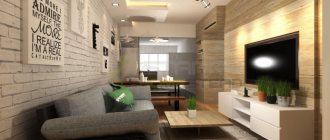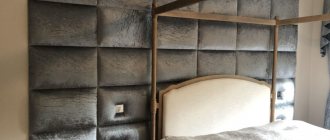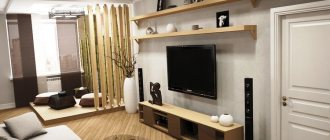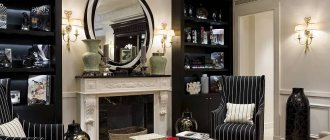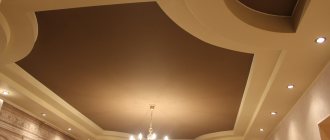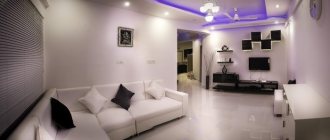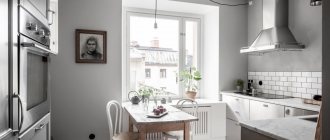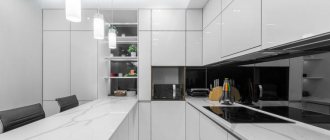Home » Decor » Wall decoration
DesignWall decorationInterior styles
Belyaeva Irina
61470 Views
A brick wall in the interior allows you to add zest to the design of your home in an affordable way. Highlighting a wall with brickwork allows you to create unusual, stylish and elegant interiors. Brick makes it possible to decorate a space in the most effective and original way. Everything will be discussed in more detail later in the article.
History and modernity
Brickwork in interior design has gained popularity thanks to lofts. Initially, the former factory premises were given to poor tenants who could not invest in a full renovation with plastering and painting.
This is how raw walls, which can be seen in old photos, came into fashion. Students and young families not only lived in such premises, but also held noisy parties with the participation of guests from various social classes.
This new direction in design became associated with bohemianism, industrialism and freedom, which appealed to city residents. Nowadays, brick wall decoration is again very popular, and can be used in combination with various styles.
You can also achieve an appearance that imitates brickwork using 3D wallpaper from picwalls.ru
Snow-white brickwork
MDF panels
This material is more environmentally friendly and durable. It is a semi-solid sheet measuring about 2.5 x 1.20 m. The embossing is shallow, but, unlike plastic, it looks more convincing. The panel is attached to liquid nails and joined to the next one, forming a continuous masonry.
The design, made with high-quality digital printing, withstands cleaning well. Not suitable for imperfectly aligned walls, but successfully hides minor defects.
Advantages and disadvantages
Any finish has its strengths and weaknesses. Let's get to know them before we start implementing our ideas.
Advantages: accessibility and simplicity
The undeniable advantages of using brick in the interior include:
- Financial inclusion.
- Safety.
- Naturalness.
- Good performance properties of the material (sound insulation, thermal insulation, moisture resistance).
- Ease of finishing. The design process using bricks allows you to cope with the task even without special skills and complex tools.
- You can use this approach in arranging almost any room.
- A brick wall can perform not only a decorative, but also a practical function - serve as a delimiter between rooms.
- Possibility to use hanging elements - shelves, lighting fixtures, TV, etc.
- Additional surface treatment is not necessary.
- Possibility of masking wall defects.
- Originality.
- Durability.
- Texture.
- Good compatibility with natural colors and natural materials.
- Decorative finishing.
Additional wall treatment is not necessary
Disadvantages: the main thing is to stop in time
There are quite a lot of advantages to this type of finishing. But what are the disadvantages?
The disadvantages of a brick wall in the interior of a house include:
- Untreated natural-colored brick needs high-quality lighting. As an alternative, you can use white brick or paint it.
- An uneven textured surface is difficult to clean.
- Too much brick in the interior design of a house can create the effect of an unkempt and cold room that lacks coziness.
An uneven surface is more difficult to maintain
The brick wall should be an original accent, and not occupy all the walls.
Kitchen and dining room with brick walls
In the kitchen spaces of typical apartments built in the last century, there are not many wall surfaces that could be lined with brick. To design a kitchen apron, you can safely use brick as a fire-resistant material that can withstand large temperature changes. To preserve the surface from moisture, it is necessary to treat the brickwork with special antiseptic sprays. If you want to create protection from grease, you will have to resort to painting.
In the kitchen spaces of private houses and large apartments there are much more opportunities for using a brick wall as a structure and interior element. For example, using an industrial motif, you can conditionally zone the dining room segment in the kitchen area. Open shelves for dishes or a display cabinet will look great against the backdrop of brick in its natural form.
It is not easy to meet among our compatriots those who have the opportunity to allocate a separate room for a dining room. In standard apartments this is simply impossible, but in private houses the dining room is most often combined with the kitchen. But if you have a large family or often host meals with guests and have the opportunity to allocate a separate room for the dining room, you should approach its design prepared. A brick wall in a dining room will become an element of surprise, raise the degree of uniqueness of the room and bring a completely unique aesthetic to the design of the space.
A wonderful continuation of the brick wall design would be to cover the kitchen apron with ceramic tiles “subway” or, as our compatriots often call it, “hog”. A harmonious combination will bring a sense of balance to the interior of the kitchen space.
The different shades of gray on the brick wall in the dining room shown in the following photo go well with the upholstery of the chairs, glass top of the dining table, wall and floor trim.
Against the background of a brick wall, the snow-white facades of the kitchen set look luxurious, expressive, and contrasting. Agree that without such finishing (or rather, its absence), a simply white kitchen would look boring, too sterile.
Real masonry or imitation: what to choose?
In addition to using real brick, its imitation, wallpaper of suitable colors or tiles of appropriate stylization can be used.
Real brick wall
In this case, the masonry made from floor to ceiling is not subject to additional plastering or hiding under sheets of plasterboard. For a spacious room with high ceilings, one of the walls of the room can be left without additional covering.
Made from real brick
But processing must be present:
- The masonry is cleaned of dust and solution residues.
- They wash.
- Grinding.
- The joints are rubbed using putty or grout.
- Possible varnishing or painting.
Decorate the living room to your taste
Wallpaper with print
The simplest and most financially uncomplicated way of decoration is wallpaper with a corresponding pattern. The effect of masonry can be created not on the entire wall, but only on certain areas, for example, niches or wall fragments. Wallpapering can be combined with other decorative materials:
- decorative putty;
- natural wood;
- tiles.
Wallpaper with a pattern
Attention should be paid to the selection of colors and expressiveness of texture. The best effect is created by high-quality design material. Separately, it should be noted that the textured wallpaper can be painted. You can even give them the desired shade yourself.
High-quality wallpaper that imitates brick can be used in places that are inconvenient for decoration with other materials:
- narrow niches;
- on surfaces that have a bevel;
- on uneven surfaces, etc.
Excellent imitation
Advice A wide field for realizing ideas is provided by photo wallpapers that combine a “brick” background with another print, for example, graffiti.
Facing brick
Facing materials are currently presented very widely. It is lighter and thinner, compared to standard brick, takes up less free space and has a low weight . This circumstance allows the use of this facing material for finishing thin walls and in cases where it is important to economically manage free space.
The material can be:
- artificially aged;
- matte;
- treated with glaze.
Cladding materials are very popular
Brick-like tiles
Brick veneer has an even thinner thickness compared to facing bricks. Tiles can be of two main types:
- clinker;
- ceramic.
Before laying, the wall surface must be pre-leveled.
Interior design element
Independent production of cladding material
In addition to the listed options, imitation brick can be made independently. This requires molds, varnish and brick plaster. This option can be used if you need to create an unusual design using bricks of a non-standard format.
Wall tiling
Unlimited possibilities are provided by modern tile material. Ceramic and clinker materials are thin and do not affect the area of the room. They can be fixed on various types of surfaces. Using brick-like tiles, you can decorate walls made of concrete slabs, wood, and plasterboard. There are certain advantages to this living room design with brick wall. Ceramic, clinker tiles:
- perfectly imitates natural masonry;
- does not require complex care;
- has a long service life;
- has decent aesthetic indicators;
- is an environmentally friendly material.
Ceramic clinker tiles do not require complex maintenance
Special adhesive compositions ensure reliable adhesion and simplify the installation process of the material.
Visual effects: how to influence the perception of space?
A wall made of traditional red brick is not the only possible option. The texture of the material and the laconic form of individual elements allows you to influence the perception of space. How to do it?
White wall
This option is used so often that it requires separate mention. Texture combined with white creates a good background for placing bright accessories.
White wall in the kitchen
The versatility of the shade allows it to be used in any room as the main design or to highlight individual zones. In white it is even possible to decorate all the walls in the room.
And at the same time the room will not look gloomy and basement. On the contrary, a light shade “adds” free space, making the room visually larger. Most often this technique is used when decorating bedrooms and kitchens.
Looks good in any room
Painting it white makes the design modern and dynamic.
Choosing colors for an interior with brick walls
The standard shade of brick walls is red-brown. But this does not mean that the interior of the room can be limited only to this color. When choosing a design, you should consider the style and purpose of the room.
The color of artificial brick in the interior can be any:
- white;
- black;
- gray;
- beige;
- colorless, etc.
To create a cozy and romantic atmosphere in the bedroom, a brick wall can be painted blue.
In addition, you can always paint the surface in any shade you like.
Helpful advice! A brown, dark blue or burgundy wall in the bedroom will give the atmosphere a romantic atmosphere, especially if you complement the interior with flickering candles.
Advantages of a white brick wall in the interior
White color is most often used in styles such as Scandinavian and minimalism. In both cases, the use of a light brick wall allows you to enrich the restrained design of the room using minimal means. In this case, it is advisable to deprive the decor of color so as not to overload the visual perception of the room.
A white brick wall will serve as an excellent backdrop for bright interior accents
Painting plain masonry is a great way to create a white brick wall in an interior. A light shade allows you to achieve the effect of visually enlarging the space, which is a definite advantage if the area of the room is limited in size. In addition, white color will be an excellent background for demonstrating decorative interior details.
Light shades visually expand the space
A combination of white brick in the interior with conventional masonry is allowed. This design is suitable for any room (bathroom, kitchen, living room or bedroom) provided it is placed correctly. White color allows you to emphasize the individuality of the room and create an exclusive interior. Even if all the walls in the room are made in white, brick of the same shade will still stand out against the general background, thanks to its pronounced texture. The atmosphere is weightless and airy.
Features of interiors with a brick wall in gray
Like white, gray is considered a neutral color. It is used by designers to create a calm background, thanks to which decorative interior elements and furniture will look as attractive as possible. Depending on the saturation, the gray wall will perform a certain function in the interior and create the desired effect.
Gray glossy brick with a reflective effect looks very original in the interior
Using a light gray color scheme you can expand the interior space of the room, as well as dim the brightness a little. This shade is ideal for rooms that are too brightly lit. Dark gray color creates an intimate and chamber atmosphere; it is calming, although it slightly hides the volume of the room. Gray color is an integral part of modern interiors in the loft or minimalist style, but it can also be used for classic interior design.
Using a red brick wall in the interior
“Red” is the name given to masonry made from ordinary clay-based bricks. However, nothing prevents the owner from repainting such a wall in any other shade over time. Red brick goes well with almost all existing styles. The classic and gothic direction is no exception.
The red brickwork immediately catches the eye and attracts attention. The wall itself can be used as the main decorative element in the interior of the room, so it does not need additional decorations.
A red brick wall will serve as the main accent in the interior of the room
Note! You should carefully select furniture for a room with a red brick wall. Some furnishings may fade or simply get lost against its background, so it is advisable to avoid simple shapes and shades that are close in tone.
We combine the incongruous
A brick wall is original, impressive and fashionable. But how can you choose the rest of the design as organically as possible?
Designers advise:
- Very often such a wall combines several shades. In this case, it is better to select furniture using the darkest and lightest colors as a basis.
- The rigor of the design can be enlivened by a bright carpet or eye-catching accents, such as colorful pillows on the sofa.
- Red brick color goes well with orange, yellow, and blue. This combination is especially effective in oriental ornaments.
Brick-like porcelain tiles
Another reliable material for wall cladding in a bathroom, hallway or loggia. Porcelain tile is environmentally friendly, can withstand high loads, looks noble, and its matte rough surface successfully imitates real brick.
It is considered an expensive type of finishing because it includes the costs of material, careful preparation of the surface and laying of tiles by professionals.
Brick in the living room interior: creating extraordinary effects
Decorating the living room with brickwork allows you to give the room a fashionable touch. The originality of this finish allows you to make the wall the main decorative element.
The larger the space in the living room, the more organic and impressive the brick wall will look. The combination with a light ceiling and wooden ceiling beams will give it style.
Organically fit into the interior
The spirit of antiquity is emphasized by the brick design of the space near the fireplace, the walls between the window openings and even the central wall. In addition to walls, brick can be used in partitions, fireplaces, etc.
Dark brick in the interior must be balanced with light shades. This can be done using furniture, textiles, and accessories.
Dark brick needs to be diluted with light furniture
Tip The presence of a fireplace in the living room can be played up by highlighting a part of the wall near it with appropriate design.
Features of decorative bricks
In appearance and physical qualities, decorative bricks for interior decoration are similar to both ordinary facing tiles and natural stone. The material is produced artificially, but its texture has a reliably natural appearance. Thanks to this, it looks original and has many options for colors and patterns.
Brick in the kitchen interior: a variety of options
The safety and durability of brick allows it to be used in the interior design of many rooms. In the kitchen it can be used in doses, allowing you to create an accent where it is needed.
Kitchen apron
This wall area is regularly exposed to steam, soot and grease. The apron occupies the space between work surfaces and wall cabinets.
Non-standard solutions
In order to facilitate the cleaning process, designers suggest adding a glass sheet to the exterior of the brickwork . This technique will preserve decorativeness and protect surfaces.
One of the walls
Decorating one of the walls with brick will look most impressive in an interior with a predominance of warm light shades:
- milky white;
- light gray;
- caramel;
- soft pink;
- cocoa shade.
Accentuating one of the walls
Part of the wall
Selecting a fragment of a wall looks no less impressive. Most often, this design is used for the dining area. In small rooms, this technique will allow you to delimit zones.
Niche
A natural or decorative niche lined with brick will help emphasize the historical orientation of the design, stylization of a rustic design, Provence style, etc. If a niche is formed near the stove, this will add retro touches to the decor.
Option for execution in the kitchen
Advice In addition to the listed options, a column in the room, a partition, a place near the bar counter, etc. can be decorated with brick.
Brickwork in the bathroom - industrial motifs in a chic setting
Many homeowners believe that using brickwork in bathrooms and toilets is an impractical design move. Of course, the palm in the matter of tiling surfaces in the bathroom belongs to ceramic tiles, but a brick wall can easily compete with it if the material is coated with antiseptic solutions. Well, brick is no stranger to constant temperature changes - it easily endures this test.
Just one small surface lined with brick can radically change the interior of a bathroom. The color of the brick goes well with the wood tones of the facade of a large chest of drawers with many drawers.
A bright red brick wall has become the main accent in the snow-white interior of the bathroom. Against the backdrop of such a colorful design, even the simplest interior items look impressive - pendant lamps, mirrors in snow-white frames. With such a colorful design of one of the walls, the snow-white utilitarian room will not look like a sterile operating room. A little “warmth” against the backdrop of a snow-white idyll will warm up a cool, sterile interior.
Brick in the bedroom interior
Brick in the design of a bedroom can be used to emphasize the character of the finish. Most often, in a bedroom, one wall or an area near the head of the bed is bricked.
Tip To add the sophistication characteristic of Provence or to endow the room with romantic features, painting the brickwork with light paint can be used.
We bring ideas to life
An office with an industrial touch - the luxury of simple solutions
If you like bold decisions in interior decoration, if some eclecticism in design, in your opinion, only benefits the environment, then you can safely use brickwork to decorate your office. This can be just one wall with the brick left in its original form, or all the surfaces of the room, slightly lightened with paint.
Styles: choosing a design option
Brick is distinguished by its versatility as a finishing material. Its use is most justified when decorating an apartment in the following styles: loft, country, Provence, etc. Such design of vertical surfaces is impressive and relevant.
Loft
Housing organized on the territory of former production premises, workshops or factories is characterized by a large area and high ceilings. These advantages allow you to implement design techniques that are not always acceptable in small apartments. These include wooden ceiling beams, columns, and brick decoration.
Loft style
The loft allows you to leave open electrical cables, heating pipes and other elements that highlight the technical engineering equipment of the house. Bricks are also a suitable backdrop for placing video and audio equipment.
Country
A style that uses natural materials and naturalness in design goes well with the design of country houses. The comfort of simple interiors with fireplaces and natural materials is emphasized by a brick tub combined with wood. This design is associated with relaxation and outdoor recreation.
Country style
Gothic
This trend dates back to the Middle Ages. The Gothic style uses brick in decoration in combination with forged parts of furniture and accessories.
Minimalism
Red brick, brown, white and gray colors should go well with the overall design - ceiling, floor and furniture.
When nothing is too much
Grunge
Mixing several styles and design trends allows you to introduce the most whimsical elements into the interior. The stylishness achieved in this way can become a distinctive feature of your home, and emphasize its dissimilarity with the homes of friends and acquaintances.
Ecostyles
Unity with nature, the use of wood, stone and natural fabrics in the design allows you to create a very cozy home. Brick, with its emphasized environmental friendliness, can become one of the components of such an interior.
We create cozy housing
High tech
Far from the word “ecologically friendly,” urban high-tech can also be combined with brickwork. Most often, imitation tiles are used for it.
Classic English interior
The emphasized rigor of design and correctness of English classics can be combined with brick elements. The touch of aristocracy and style inherent in medieval castles of the English nobility can be accentuated by the use of brick decoration.
Refresh with a light sofa
Using bricks: tips and tricks
How to preserve masonry and avoid tarnishing and defects?
Real brick is beautiful in itself, has a pronounced texture and a characteristic shade. How to preserve it without losing quality characteristics and color? For this, interior designers advise using special protective compounds.
If there is a lack of light, which occurs, for example, in a hallway, the wall can be varnished with a slight glossy effect. This will ensure color preservation.
In sunny rooms, you can varnish with a matte effect. Such protection will be completely invisible, but at the same time quite reliable.
In an industrial interior
Is old brick good or bad?
The old brick wall looks historic, attractive in its rugged beauty. But for the interior it must first be put in order. For this purpose, brushing is used. You may need to wipe the stained areas with a mixture of vinegar and water.
Advice: Before using aggressive cleaning agents, check the condition of the brick. A crumbling surface cannot be treated this way.
With the effect of old brick
High humidity: how to overcome it?
In rooms where there is often high humidity, such as a bathroom, protecting the brickwork comes first. To do this, the crumbled seams are deepened a couple of centimeters, and then restored with a new solution. The next step is sealing to protect against mold.
Protecting brickwork
Ready-made gypsum tiles
This is one of the simplest and most successful ways to decorate a wall: the tiles are sold in boxes, their quantity is easy to calculate.
It weighs little and requires minimal effort when facing. It comes in a variety of colors and can imitate aged masonry. Gypsum “bricks” are attached with special glue. Carry out the cladding as carefully as possible so that the adhesive is not visible in the seams. The finished wall can be painted to even out the color, or varnished.
Another advantage of facing tiles is its environmental friendliness, since gypsum is a natural material. The wall will last for several years and will provide additional sound insulation.
Work on mistakes
Using such a simple and yet quite complex material, it is necessary to take into account some features of brick:
- Once the wall is painted, it is extremely difficult to remove the paint if necessary. This is due to the porosity of the structure and good absorption.
- It is not advisable to completely highlight a long wall with brick. In this case, it must be “broken” with pieces of furniture, mirrors or decor. This way it will be better perceived visually.
- Mirrors reflecting a brick wall will help unite the space of the room into a single ensemble.
- The paintings look very beautiful on brick walls. The more there are, the more attention is drawn to the wall itself.
- Hanging open shelves hung on such a wall add coziness. Their color and material are selected taking into account the style of the room.
Bright accent
VIDEO: How can you use brick on a wall?
Brick wall
Ideas for your interior
Varieties
When choosing an artificial analogue, it is important to understand what characteristics each material has.
Plaster
Decorative gypsum brick has many advantages: it is a light-weight, inexpensive material, which also does not require complicated installation - it is fixed to the wall with PVA glue or mastic. In addition, it is environmentally friendly, has good hygroscopicity and does not cause allergies, since it is made from natural materials: gypsum, quartz squeak, marble chips, water. And most importantly, it is almost identical to natural brick in texture and color. The disadvantages are that it is easily susceptible to mechanical stress (the surface can be damaged even by a slight blow) and temperature changes, and is not resistant to moisture. Because of this, the scope of application is significantly reduced: gypsum imitation is not suitable for the bathroom and kitchen.
Instagram @osome.studio
Instagram @citsilia_stalinka
Clinker
This material has high technical characteristics. Thanks to the use of high temperatures during manufacturing, it is durable and resistant to water and temperature changes. The result is high cost.
Instagram @art_osobinka
Instagram @alexey_volkov_ab
Cement
It is made from a mixture of cement and modifying components, which is poured into special rectangular molds that exactly replicate the relief of natural brick.
Its new modification is a hyper-pressed material, the composition contains a small percentage of cement (up to 15%) and various waste rocks, which are mixed, moistened and pressed under high pressure. Externally it can be of any color: from imitation of the original to bright light or dark shades.
Instagram @marideco.ru
Instagram @valindays
- Walls
3 ways to make an imitation brick wall with your own hands
Ceramic
A popular choice for facing brick walls. The main component is clay, which is molded and fired. Dyes can be added to the composition, resulting in a wide variety of shades. The result is a reliable, wear- and frost-resistant coating, which also improves the thermal insulation of the room.
Instagram @olgabondar_design
Instagram @studiotate
Other brick cladding options
In addition to direct analogues, there are other ways to visually create an imitation of real briquettes on the wall.
For example, PVC or MDF panels, acrylic tiles, printed wallpaper.
Instagram @a_gorskaya
Instagram @n.prchk
Instagram @blg_interior
